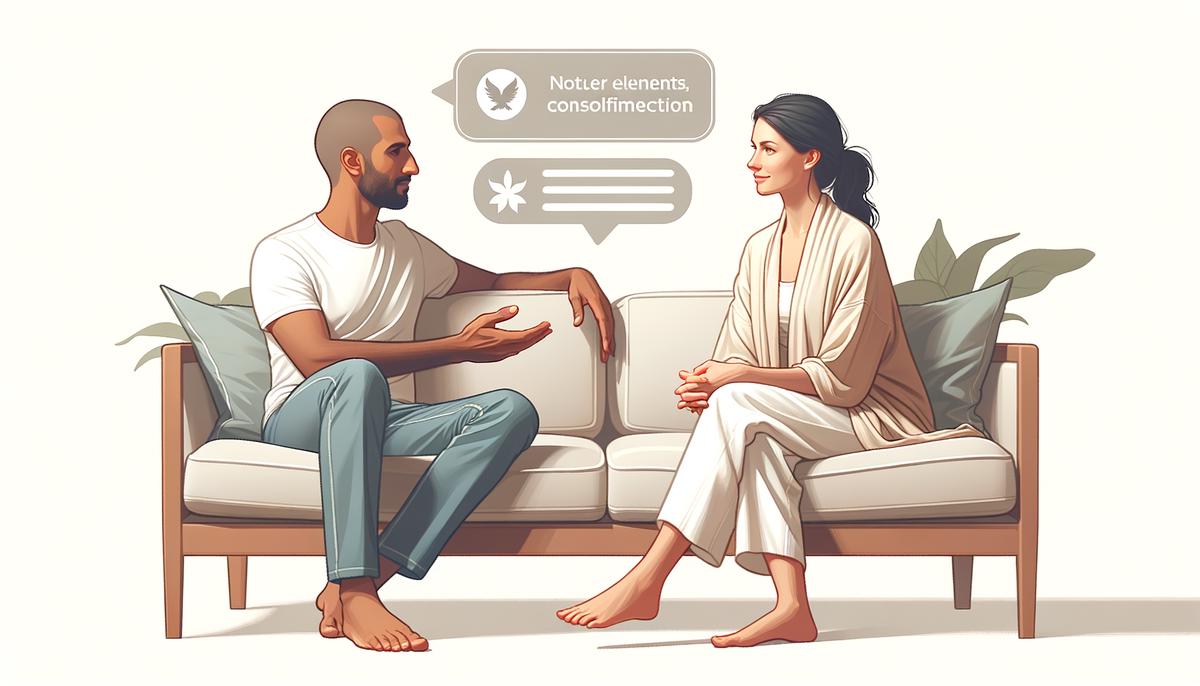Communication in relationships is akin to the gentle ebb and flow of the ocean’s tides, constantly moving and reshaping the landscape of our connections. It’s a delicate balance of listening, understanding, and expressing, where each element plays a critical role in fostering a nurturing environment for love to grow and thrive. As we journey through the nuances of effective communication, we uncover the tools and strategies that can transform our interactions into bridges of deeper understanding and connection.
The Essence of Effective Communication
In the dance of relationship dynamics, active listening steps in as a pivotal move. It’s about tuning into your partner’s words without mentally preparing your next argument. Think of it like catching every pitch in baseball; you’re focused, ready, and fully in the moment. When both partners truly hear each other, misunderstandings shrink and empathy grows.
Empathy shines as the heart’s response in this communication ballet. It’s stepping into your partner’s shoes, maybe even trying on their socks, to genuinely feel what they’re experiencing. By understanding each other’s feelings and viewpoints, partners can navigate the choppy waters of disagreements with more compassion and less conflict.
Clear articulation of needs and desires acts as the bridge between hearts and minds. Imagine you both are painters, but instead of a panorama on canvas, you’re describing your deepest needs and wishes. This doesn’t mean dropping hints or expecting them to read between the lines like a seasoned detective. It’s about being open, straightforward, and honest, which, like direct sunlight, can disinfect the festering wounds of miscommunication.
These elements create a nurturing climate of trust and respect. Trust builds as predictably as a plant towards sunlight, flourishing under consistent care and honesty. Respect follows, growing roots deep into the relationship soil, when both partners acknowledge and honor their differences and peculiarities.
A relationship without effective communication is like a ship without a compass, subject to the tides of misunderstanding and conflict. But with these tools—active listening, empathy, and clear expression of needs—partners can steer their relationship through both calm and stormy seasons with grace, understanding, and deep companionship.

Navigating Conflict Through Communication
Focusing on positive language during heated conversations redirects the energy from negative to constructive. By using “I feel” statements rather than “You always” accusations, individuals take ownership of their emotions without placing undue blame on their partner. This small shift not only softens the delivery but also encourages a more responsive rather than defensive reaction.
Setting boundaries becomes crucial when managing conflicts. Each person should clearly define what is acceptable and what isn’t in a disagreement. This doesn’t mean setting rigid rules that strangle the dialogue but rather ensuring both parties feel safe expressing themselves without the fear of crossing invisible lines.
Practicing patience allows each partner the time to process and reflect on the other’s perspective. Rushing to resolve can often lead to superficial agreements that don’t address the root of the issue. True resolution comes from understanding each other’s viewpoints and feelings, which takes time.
Acknowledging each other’s efforts and good intentions strengthens the relationship by focusing on the positive aspects each partner brings to the table. Recognizing efforts, even when disagreements occur, cements a sense of team spirit and mutual respect.
Taking breaks when necessary should not be viewed as avoidance but rather as a strategic pause to cool down, gather thoughts, and approach the conversation with a clearer mind. Sometimes, distancing oneself from the heat of the moment can provide a fresh perspective and potential solutions.
Seeking external support from a therapist or a counselor can provide an impartial viewpoint and professional tools for navigating conflict more effectively. Sometimes, an outside perspective can illuminate underlying issues that couples are too close to see or have difficulty addressing on their own.
Focusing on shared goals instead of differences changes the dynamic from opposition to collaboration. Couples often find that they have the same endgame in mind but differ in their methods to achieve it. Highlighting common objectives can redirect energy towards working together rather than against each other.
Learning from each disagreement paves the way for a stronger and more resilient relationship. Every conflict presents an opportunity for growth, offering insights into each other’s needs and how to better meet them moving forward. Transforming disputes into lessons strengthens not just the bond between partners but also their individual self-awareness and emotional intelligence.
Understanding that disagreements are a normal and healthy part of any relationship demystifies conflict, allowing couples to approach disagreements with less fear and more confidence in their resolution skills. This acceptance encourages a proactive rather than a reactive stance on conflicts, marking a significant shift in how couples navigate their challenges together.

The Role of Nonverbal Communication
Facial expressions often reveal inner emotions and can help partners understand each other without a single word. A smile, for instance, can light up a room and ease tension, while a frown might express disapproval or concern.
Gestures, too, play a crucial role. Imagine the warmth felt when a partner offers a comforting hand squeeze during a stressful moment. Conversely, a dismissive wave of the hand can hurt, signaling a lack of interest or care.
Posture and body orientation convey interest and attentiveness. Leaning in during a conversation signals engagement and warmth, fostering closer emotional connections. On the other hand, crossed arms might be perceived as defensive or closed off, building barriers.
Tone of voice carries the weight of our words, often communicating more accurately than the words themselves. A gentle tone can calm fears, while a harsh tone might provoke anxiety or anger.
The space we maintain from our partners, known as proxemics, also tells a story. Being physically close can create a sense of intimacy and security, while distance might hint at disconnection or a need for personal space.
Timing and frequency of responses in conversation indicate responsiveness and interest. Quick replies can show eagerness and engagement, whereas delayed responses might suggest distraction or disinterest.
Mirroring, or subconsciously adopting the other’s posture or gestures, often signals alignment and rapport. It’s a powerful tool in bonding, as it reflects empathy and harmony in the relationship.
Eye contact is pivotal. Holding a partner’s gaze communicates sincerity and trustworthiness. Avoiding eye contact, however, can be interpreted as detachment or discomfort.
Facial warmth gestures such as nodding encourage openness, telling the other person their thoughts are valued. It fosters a supportive environment where both parties feel heard and respected.
Experimentation with personal touch, understanding when and how to incorporate it, can intensify feelings of love and connection. Small acts, like a caress of the cheek or an impromptu hug, nurture bonds and communicate affection without words.
Introducing playful, light touches during conversations can relieve pressure and add joy to daily interactions. It’s small actions like these that sometimes speak louder than words in conveying care and love.
Understanding and interpreting these unspoken signals can help navigate through relationship challenges more effectively. It takes practice to become adept at reading nonverbal cues, but the payoff is substantial, paving the way for deeper mutual understanding and connection.
Respecting personal boundaries in nonverbal communication ensures a comfortable space for both. Observing and adjusting to each other’s comfort levels with physical distance and touch fosters trust and respect.
Lastly, acknowledging nonverbal efforts made by a partner strengthens the relationship. Recognizing these silent expressions of love and care validates their significance and contributes to an enduring bond.

Communication and Emotional Intimacy
Sharing private thoughts and secret dreams can significantly intensify the bond between partners. Revealing one’s authentic self, displaying true sentiments, ambitions, and vulnerabilities, paves the way for deep emotional connection. This transparency ushers in genuine understanding and compassion, furthering empathy and closeness.
Daily check-ins, exchanging simple queries about each other’s day, can steadily reinforce the foundation of emotional intimacy. Such seemingly trivial interactions uphold the continuous flow of communication, keeping the emotional channels open and vibrant. These moments, far from superficial, are threads woven into the fabric of relational intimacy.
Celebrating successes together, both big and small, is a vital aspect of enhancing emotional intimacy. Acknowledging each other’s victories not only fosters a sense of shared joy but signals a profound mutual support. This act of celebration solidifies the partnership, reinforcing the notion that achievements are appreciated and valued collectively.
Expressing gratitude regularly plays a pivotal role in deepening emotional connection. Simple expressions of thanks for everyday acts or qualities observed in one’s partner sow seeds of positivity, growing a garden of contentment and mutual respect. Gratitude amplifies the good, diluting negativity and strengthening the bonds of intimacy.
Sharing personal growth experiences, including revelations from personal introspection or therapy, constitutes a bridge to greater emotional intimacy. As individuals evolve, inviting their partner into their journey fosters a mutual understanding and an alignment of personal transformations. This shared growth nurtures a profound connection grounded in the current reality of each person’s evolution.
Introducing humor and laughter into communication can be transformative, breaking barriers and smoothing over potential tensions. Jokes and light-hearted banter stimulate joy and ease, creating a buffer against the stressors that threaten intimacy. Shared laughter is a powerful tool, fostering a warm, jovial atmosphere that enhances connection.
Reflecting on past experiences together, revisiting memories of shared journeys or challenges overcome, can fortify the emotional bond. This shared narrative highlights resilience as a couple, underscoring the strength drawn from each other. Reminiscing about these collective experiences renews appreciation for the partnership and deepens emotional ties.
Navigating difficult conversations about future aspirations or fears demonstrates a commitment to vulnerability and truth. Openly discussing these topics, even when they bring discomfort, shows a dedication to growth and honesty in the relationship. It is through these tough dialogues that trust is fortified, opening doors to unmatched levels of understanding and mutual support.
Engaging in mutual vulnerability by sharing fears and insecurities opens a sacred space for profound emotional intimacy. This deliberate unveiling acts as an invitation for one’s partner to share their own vulnerabilities, forging a bond centered on trust and empathy. The courage to be vulnerable becomes the glue that cements a deep, lasting connection.
Committing to usability in dialogue enables partners to peel back layers over time, revealing their authentic selves. This commitment advocates for honesty in exchange, where each conversation, regardless of topic gravity, is approached with respect and authenticity. This ongoing honest communication nurtures an ever-deepening well of understanding and emotional intimacy.
By adopting these approaches, partners craft an environment where emotional intimacy flourishes, laying a strong foundation for a resilient and fulfilling relationship. This dynamic interplay of open communication, shared vulnerability, celebration, gratitude, laughter, reflection, honest discussions, and commitment to authenticity cultivates a deeply rooted emotional intimacy that endures the test of time.

Adapting Communication in Long-Term Relationships
As time marches on within a long-term relationship, recognizing and adapting to the nuances of emotional growth becomes essential. Couples learn that the heartbeat of their partnership often lies in the unsaid, in the spaces between words and actions. Adjusting communication styles to these evolving emotional landscapes ensures the longevity and depth of the connection.
Develop interests together, pursuing hobbies or activities that both enjoy, becomes a language of love and companionship in itself. It’s a way to speak volumes without saying a word, uniting in shared experiences that enrich your bond. It reinforces the idea that growing together involves not just facing life’s challenges side by side but also embracing its joys and adventures as a team.
Introducing regular date nights or surprise moments can revive the initial spark of romance, reminding both partners why they fell in love. Whether it’s revisiting the site of your first date or trying something entirely new, these moments encourage spontaneity in communication and rejuvenate the relationship’s dynamic.
Cultivating a habit of expressing love and affection in varied ways keeps the emotional climate of the relationship vibrant. Words of affirmation, acts of service, receiving gifts, quality time, and physical touch, as Dr. Gary Chapman outlines in his book “The 5 Love Languages,” all play a crucial role in communicating feelings and needs effectively.
Learning to navigate technology’s impact on communication plays a crucial role in modern relationships. Setting boundaries around screen time, being present during conversations, and using technology to stay connected through the day can enhance communication. Instead of allowing it to be a barrier, turn technology into a tool that helps you stay connected.
Expressing curiosity about your partner’s day, thoughts, or feelings fosters an environment of continuous exploration and interest. It’s about showing you’re still intrigued by your partner’s mind and spirit, even years down the line. This curiosity strengthens the bond by ensuring that both individuals feel seen and heard.
Adapting to changes in communication as both partners evolve, whether through career shifts, family dynamics, or personal growth, offers an opportunity to deepen understanding and empathy towards each other. Recognizing and supporting these changes demonstrates a commitment to the relationship’s growth and each other’s individual journeys.
Encouraging independence and personal space in the relationship allows both partners to grow individually without feeling stifled. Balancing shared experiences with personal time results in a healthier dynamic, where communication breeds not from necessity but from a genuine desire to share and connect.
Lastly, creating traditions together, whether nightly, weekly, or annually, provides a structured occasion for connection and communication. These rituals become cornerstones of the relationship, offering consistency and comfort through life’s inevitably changing circumstances.
Embracing these strategies doesn’t just answer the call for evolving communication; it welcomes the unfolding layers of partnership with grace and fortitude. By continually adapting and responding with intention and care, couples ensure their journey together is marked not by how they navigated their beginnings but by how they embraced their evolution together.

In the grand tapestry of relationships, effective communication stands out as the thread that weaves together the fabric of understanding, trust, and emotional intimacy. By embracing active listening, empathy, and clear expression of needs, we not only navigate the challenges but also celebrate the joys of our connections. This commitment to open and heartfelt dialogue is the cornerstone upon which lasting relationships are built, ensuring that our bonds deepen and flourish over time.







